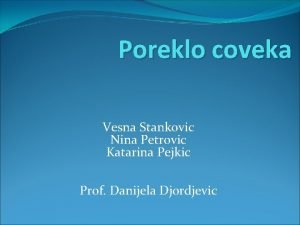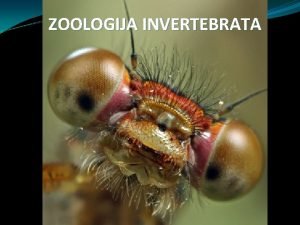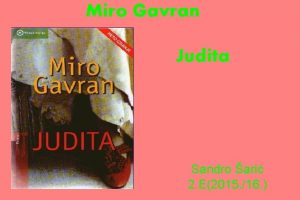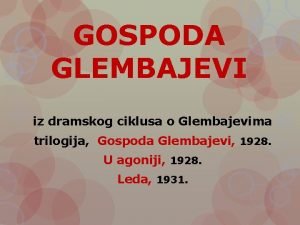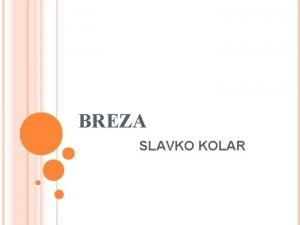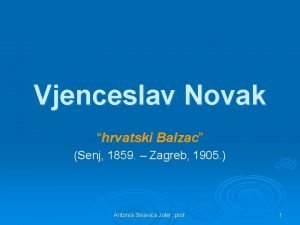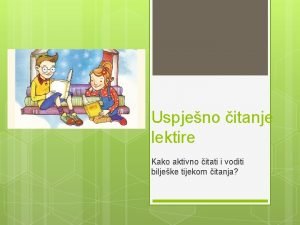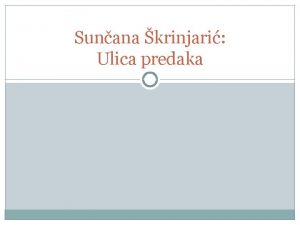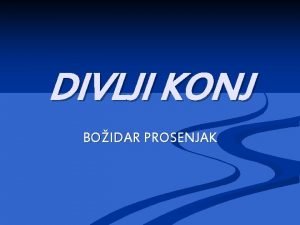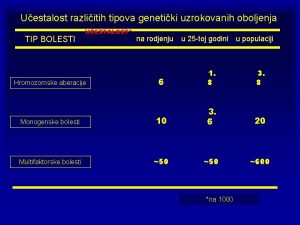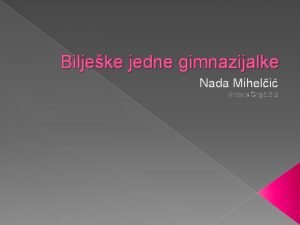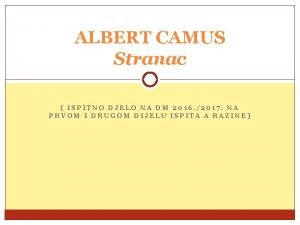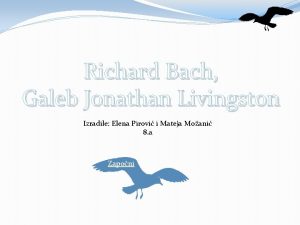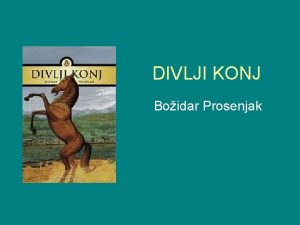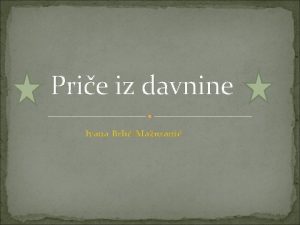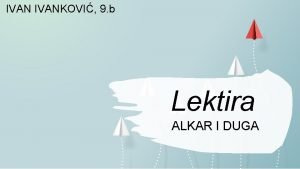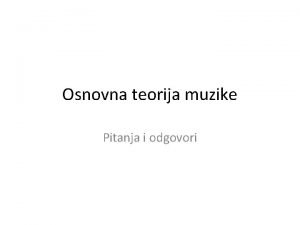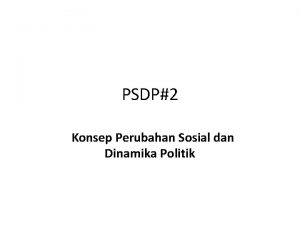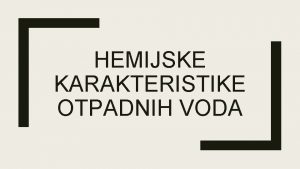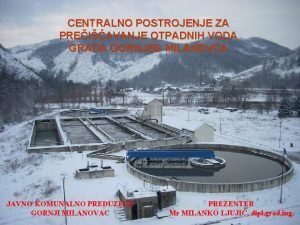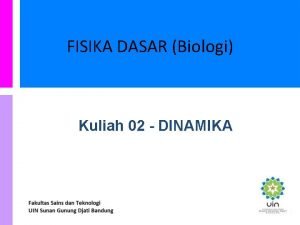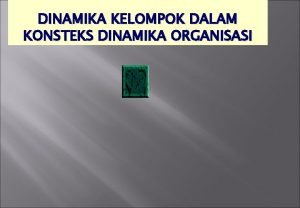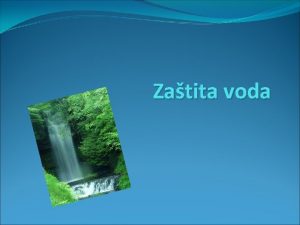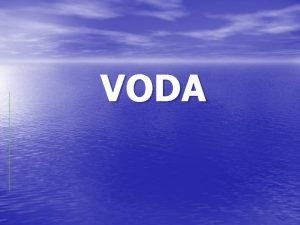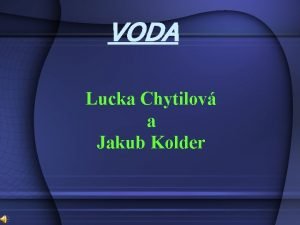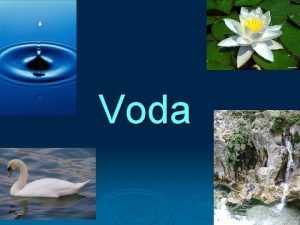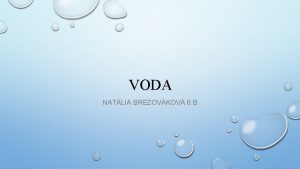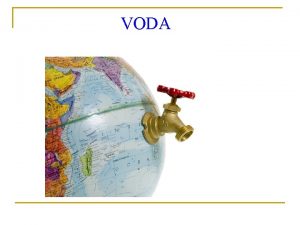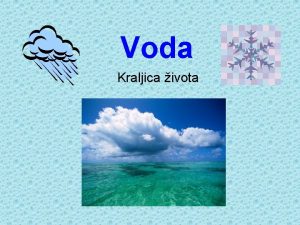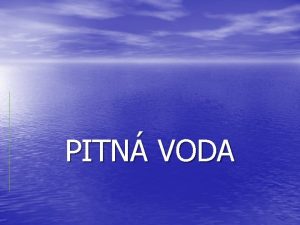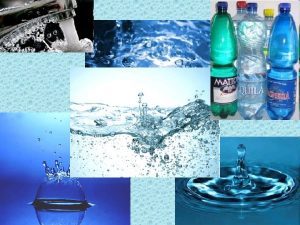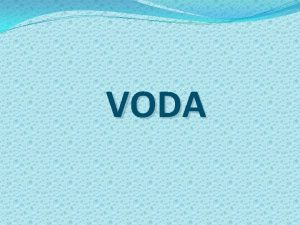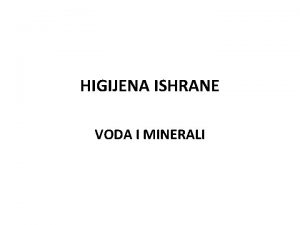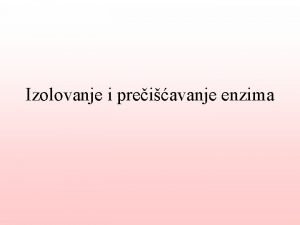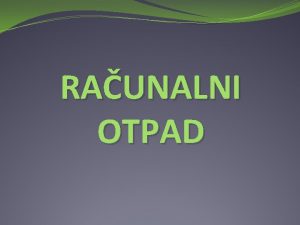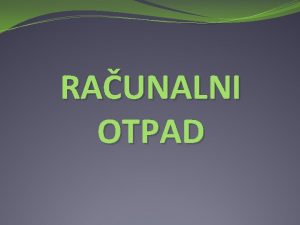Otpadna voda poreklo i dinamika nastajanja karakterizacija preiavanje






















- Slides: 22

Otpadna voda, poreklo i dinamika nastajanja, karakterizacija, prečišćavanje ___________________________________________________ This project has been funded with support from the European Commission. This publication reflects the views only of the authors, and the Commission cannot be held responsible for any use which may be made of the information contained therein.

• voda koja je onečišćena na bilo koji način tokom upotrebe • u opštem slučaju rastvorenim i nerastvornim organskim i neorganskim materijama i mikroorganizmima • iz naselja i industrije, zatim iz poljoprivrede i stočarstva, pri čemu najveće ukupno zagađenje emituje industrija. ___________________________________________________ This project has been funded with support from the European Commission. This publication reflects the views only of the authors, and the Commission cannot be held responsible for any use which may be made of the information contained therein.

• Tabela 1. Zagađivači u otpadnoj vodi i njihov uticaj na ekosistem recipijenta ___________________________________________________ This project has been funded with support from the European Commission. This publication reflects the views only of the authors, and the Commission cannot be held responsible for any use which may be made of the information contained therein.

• uzorkovanje otpadne vode treba prilagoditi konkretnim okolnostima (obično standardi kvaliteta propisuju i način uzorkovanja) • intervali između uzorkovanja moraju biti kratki kako bi se dobio reprezentativni uzorak • čuvanje uzorka do momenta analize ___________________________________________________ This project has been funded with support from the European Commission. This publication reflects the views only of the authors, and the Commission cannot be held responsible for any use which may be made of the information contained therein.

Fizičke karakteristike otpadne vode • sadržaj suve materije (SM) • definiše se kao ostatak nakon sušenja uzorka na 103 -105°C, pri čemu na ovaj način nisu obuhvaćeni sastojci sa niskom tačkom ključanja. • suva materija se filtracijom preko membrane prečnika 0, 45 μm razdvaja na suspendovane čestice (prečnik od 1μm i više), i filtrat koji čine koloidne čestice i rastvor (organski i neorganski molekuli i joni rastvoreni u vodi) ___________________________________________________ This project has been funded with support from the European Commission. This publication reflects the views only of the authors, and the Commission cannot be held responsible for any use which may be made of the information contained therein.

Fizičke karakteristike otpadne vode • žarenjem na 550± 50°C se uklanja („isparava”) organska i mali deo neorganske suve materije • suva materija, koja se gubi žarenjem, definiše se kao „organska suva materija” (o. SM). • Ostatak posle žarenja, koji predstavlja neorgansku frakciju suve materije, naziva se „pepeo“ ___________________________________________________ This project has been funded with support from the European Commission. This publication reflects the views only of the authors, and the Commission cannot be held responsible for any use which may be made of the information contained therein.

Fizičke karakteristike otpadne vode • Boja • na osnovu boje može se izvršiti gruba procena stanja otpadne vode • „sveže“ otpadne vode obično su sive boje, dok kod „odležalih“ otpadnih voda, nakon utroška celokupnog rastvorenog kiseonika delovanjem aerobnih mikroorganizama i nakon nastanka anaerobnih (septičkih) uslova, boja prelazi u crnu ___________________________________________________ This project has been funded with support from the European Commission. This publication reflects the views only of the authors, and the Commission cannot be held responsible for any use which may be made of the information contained therein.

Fizičke karakteristike otpadne vode • Miris • obično potiče od gasova koji nastaju u procesu raspada organske materije • karakterističan miris septičkih otpadnih voda (na pokvarena jaja) potiče u najvećoj meri od vodonik-sulfida koji nastaje u anaerobnim uslovima mikrobiološkom redukcijom sulfata ___________________________________________________ This project has been funded with support from the European Commission. This publication reflects the views only of the authors, and the Commission cannot be held responsible for any use which may be made of the information contained therein.

Fizičke karakteristike otpadne vode • Temperatura • utiče na biosvet vodotokova u koje se ispuštaju takve vode, zato što se na višim temperaturama rastvorljivost kiseonika u smanjuje ___________________________________________________ This project has been funded with support from the European Commission. This publication reflects the views only of the authors, and the Commission cannot be held responsible for any use which may be made of the information contained therein.

Hemijske karakteristike otpadne vode • Organske materije • određuje se ukupan sadržaj organske materije • biohemijska potrošnja kiseonika (BPK): BPK je mera količine kiseonika koja je potrebna mikroflori samog uzorka otpadne vode da oksiduje organski ugljenik • najčešće se određuje BPK u toku 5 dana na temperatiri od 20°C, tzv. BPK 5, pri čemu se smatra da se tom analizom obuhvata oko 60 do 70% biorazgradivih organskih materija ___________________________________________________ This project has been funded with support from the European Commission. This publication reflects the views only of the authors, and the Commission cannot be held responsible for any use which may be made of the information contained therein.

Hemijske karakteristike otpadne vode • Hemijska potrošnja kiseonika (HPK) • količina kiseonika iz jakog hemijskog oksidanta kojim se oksiduje organska materija u vodi (koristi se kalijumdihromat u kiseloj sredini, a postiže se 95 do 100% učinak oksidacije većine organskih jedinjenja). • BPK/HPK ___________________________________________________ This project has been funded with support from the European Commission. This publication reflects the views only of the authors, and the Commission cannot be held responsible for any use which may be made of the information contained therein.

Hemijske karakteristike otpadne vode • Ukupni organski ugljenik (TOC) • mera sadržaja organski vezanog ugljenika u otpadnoj vodi • određuje se merenjem količine CO 2 nastalog oksidacijom organskog ugljenika • TOC je bolji pokazatelj sadržaja organskih materija u otpadnoj vodi, ali kako on ne daje istu vrstu informacije, njme se ne zamenjuje određivanje BPK i HPK ___________________________________________________ This project has been funded with support from the European Commission. This publication reflects the views only of the authors, and the Commission cannot be held responsible for any use which may be made of the information contained therein.

Hemijske karakteristike otpadne vode • Proteini, ugljeni hidrati, ulja i masti • različit uticaj na ekosistem, i različito se ponašaju usled prečišćavanja • proteini su važan izvor azota u vodotokovima, a u proceesu njihove razgradnje naastaju veoma neprijatni mirisi. • Ulja stvaraju tanak sloj na površini i ugrožavaju živi svet u vodi (otežan unos kiseonika) ___________________________________________________ This project has been funded with support from the European Commission. This publication reflects the views only of the authors, and the Commission cannot be held responsible for any use which may be made of the information contained therein.

Hemijske karakteristike otpadne vode • Specifična organska jedinjenja, površinski aktivne materije, pesticidi, fenoli • sporo biološki razgradive, neke čak i nerazgradive, a često i veoma toksične • površinski aktivne materije izazivaju penjenje na površini vodotokova (otežavaju unos kiseonika) • pesticidi i fenoli smanjuju upotrebnu vrednost vode recipijenta (ako se voda hloriše nastaju i hlorfenoli koji su veoma neprijatnog mirisa) ___________________________________________________ This project has been funded with support from the European Commission. This publication reflects the views only of the authors, and the Commission cannot be held responsible for any use which may be made of the information contained therein.

Hemijske karakteristike otpadne vode • Neorganske materije • azot, fosfor, sumpor • azot i fosfor - rast biljaka i tzv. eutrofikaciju vodotokova • azot se nalazi u različitim oblicima (organski, amonijačni, nitritni i nitratni azot) • sumpor se iz sulfata u anaerobnim uslovima prevodi u toksičan vodoniksulfid, koji može oksidovati do veoma korozivne sumporne kiseline ___________________________________________________ This project has been funded with support from the European Commission. This publication reflects the views only of the authors, and the Commission cannot be held responsible for any use which may be made of the information contained therein.

Hemijske karakteristike otpadne vode • PH, alkalitet, kiselost • ekstremna p. H otpadnih voda (visoka ili niska) otežaće njeno biološko prečišćavanje i negativno uticati na živi svet • teški metali, toksične supstance • u pojedinim otpadnim vodama nalaze se velike koncentracije teških metala (Pb, Cd, Cr, Hg itd. ) koji su toksični • toksične supstance kao što su cijanidi, hlorovana organska jedinjenja itd. ___________________________________________________ This project has been funded with support from the European Commission. This publication reflects the views only of the authors, and the Commission cannot be held responsible for any use which may be made of the information contained therein.

Klasifikacija načina prečišćavanja • uklanjanje zagađenja otpadne vode do te mere da obrađena otpadna voda može da se ispušta u recipijent bez štetnih posledica ili da može da se ponovo upotrebi • deli se na: • prethodnu obradu, • primarno, sekundarno i tercijarno prečišćavanje i • obradu i odlaganje muljeva koji nastaju tokom prečišćavanja otpadnih voda ___________________________________________________ This project has been funded with support from the European Commission. This publication reflects the views only of the authors, and the Commission cannot be held responsible for any use which may be made of the information contained therein.

Klasifikacija načina prečišćavanja • Prethodna obrada otpadnih voda obuhvata uklanjanje grubog suspendovanog i plivajućeg materijala, uklanjanje inertnog materijala, plivajućeg ulja i ujednačavanje protoka i koncentracije otpadnih voda. • Primarnm prečišćavanjem se iz otpadnih voda uklanjaju suspendovane i emulgovane materije, taloženjem, filtracijom ili flotacijom. ___________________________________________________ This project has been funded with support from the European Commission. This publication reflects the views only of the authors, and the Commission cannot be held responsible for any use which may be made of the information contained therein.

Klasifikacija načina prečišćavanja • Sekundarnim prečišćavanjem se uklanjaju koloidne i deo rastvorenih organskih materija biološkim ili hemijskim putem • Tercijarno prećiščavanje se primenjuje za uklanjanje ostaog zagađenja, kao što su biogeni elementi, bionerazgradive organske materije, organske materije. . . ___________________________________________________ This project has been funded with support from the European Commission. This publication reflects the views only of the authors, and the Commission cannot be held responsible for any use which may be made of the information contained therein.

___________________________________________________ This project has been funded with support from the European Commission. This publication reflects the views only of the authors, and the Commission cannot be held responsible for any use which may be made of the information contained therein.

Author, Editor and Referee References This remote access laboratory was created thanks to work done primarily at University of Niš. Contributors to this material were: ________ Refereeing of this material was done by: ___________ Editing into NETCHEM Format and onto NETCHEM platform was completed by: __________________________________________________________ This project has been funded with support from the European Commission. This publication reflects the views only of the authors, ___________________________________________________ andhas the been Commission be held responsible for any use which may made of the information contained This project funded cannot with support from the European Commission. Thisbe publication reflects the views only of therein. the authors, and the Commission cannot be held responsible for any use which may be made of the information contained therein.

References and Supplemental Material The NETCHEM platform was established at the University of Nis in 2016 -2019 through the Erasmus Programme. Please contact a NETCHEM representatives at your institution or visit our website for an expanded contact list. The work included had been led by the NETCHEM staff at your institution. ___________________________________________________ This project has been funded with support from the European Commission. This publication reflects the views only of the authors, ___________________________________________________ andhas the been Commission be held responsible for any use which may made of the information contained This project funded cannot with support from the European Commission. Thisbe publication reflects the views only of therein. the authors, and the Commission cannot be held responsible for any use which may be made of the information contained therein.
 Poreklo coveka
Poreklo coveka Monofiletsko poreklo
Monofiletsko poreklo Miro gavran judita pdf
Miro gavran judita pdf Divlji konj pouka
Divlji konj pouka Mutno je sve to u nama draga moja dobra beatrice
Mutno je sve to u nama draga moja dobra beatrice Branka primorac maturalac
Branka primorac maturalac Bikovski vrh
Bikovski vrh Posljednji stipančići likovi
Posljednji stipančići likovi Trojica u trnju osobine likova
Trojica u trnju osobine likova Socijalna karakterizacija lika
Socijalna karakterizacija lika Divlji konj kratki sadrzaj
Divlji konj kratki sadrzaj Premutacija
Premutacija Zeleni pas likovi
Zeleni pas likovi Albert camus stranac
Albert camus stranac Galeb jonathan livingston stilske figure
Galeb jonathan livingston stilske figure Kiklop don fernando
Kiklop don fernando Divlji konj likovi
Divlji konj likovi Kratki sadržaj priče iz davnine
Kratki sadržaj priče iz davnine Zlatarovo zlato karakterizacija likova
Zlatarovo zlato karakterizacija likova Duga lektira kviz
Duga lektira kviz Divlji konj karakterizacija likova citati
Divlji konj karakterizacija likova citati šta je tempo
šta je tempo Perubahan sosial dan dinamika politik
Perubahan sosial dan dinamika politik
